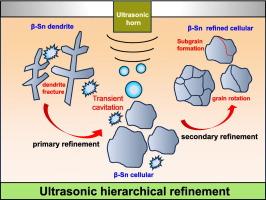通过超声分层细化实现SnBi合金强度和延性的同时增强
IF 5.5
2区 材料科学
Q1 MATERIALS SCIENCE, CHARACTERIZATION & TESTING
引用次数: 0
摘要
SnBi合金在热界面材料、油井桥塞、半导体封装等领域有着广泛的应用前景,但其原生枝晶长而粗,延展性较差。本文对Sn30Bi (wt%)熔体进行超声处理,使其枝晶破碎,组织细化,进一步提高凝固合金的力学性能。系统研究了超声参数对合金枝晶尺寸、晶粒组织和力学性能的影响。结果表明,在165℃、超声振幅10 μm、超声振动时间30 s的超声处理下,Sn30Bi合金的显微组织由粗晶β-Sn枝晶重新组织为平均尺寸为55 μm的等轴胞状组织,晶粒进一步细化至平均尺寸为25 μm。这种分层细化使Sn30Bi合金的强度提高了20%(从59mpa提高到71mpa),伸长率提高了54%(从12%提高到19%)。从枝晶到胞体的一次细化扩展了裂纹扩展路径,而胞内的二次细化强化了β-Sn胞体,进一步导致裂纹偏转和止裂。超声加工参数与合金组织的相关性为SnBi合金熔体处理提高力学性能提供了实践指导,而超声处理引起的分层细化加深了超声对合金组织影响的机理认识。本文章由计算机程序翻译,如有差异,请以英文原文为准。

Achieving simultaneous strength-ductility enhancement of SnBi alloys via ultrasonic hierarchical refinement
Sn![]() Bi alloys, a promising candidate widely used in thermal interface materials, oil well plugs, and semiconductor packaging, suffer from low ductility due to the long and coarse primary dendrites. In this paper, an ultrasonic treatment strategy was implemented on the Sn
Bi alloys, a promising candidate widely used in thermal interface materials, oil well plugs, and semiconductor packaging, suffer from low ductility due to the long and coarse primary dendrites. In this paper, an ultrasonic treatment strategy was implemented on the Sn![]() 30Bi (wt%) melt to fragment the dendrites, refine the microstructures, and further enhance the mechanical properties of solidified alloys. The effects of ultrasonic parameters on dendrite size, grain structures, and mechanical properties of the alloy were systematically investigated. It is found that the microstructures of Sn
30Bi (wt%) melt to fragment the dendrites, refine the microstructures, and further enhance the mechanical properties of solidified alloys. The effects of ultrasonic parameters on dendrite size, grain structures, and mechanical properties of the alloy were systematically investigated. It is found that the microstructures of Sn![]() 30Bi alloys were reorganized from coarse β-Sn dendrites to equiaxed cellular structures with an average size of 55 μm, and the grain size was further refined to an average size of 25 μm under the ultrasonic treatment temperature of 165 °C, ultrasonic amplitude of 10 μm, and ultrasonic vibration duration of 30 s. This hierarchical refinement led to a 20 % increase in strength (from 59 MPa to 71 MPa) and a 54 % improvement in elongation (from 12 % to 19 %) for the Sn
30Bi alloys were reorganized from coarse β-Sn dendrites to equiaxed cellular structures with an average size of 55 μm, and the grain size was further refined to an average size of 25 μm under the ultrasonic treatment temperature of 165 °C, ultrasonic amplitude of 10 μm, and ultrasonic vibration duration of 30 s. This hierarchical refinement led to a 20 % increase in strength (from 59 MPa to 71 MPa) and a 54 % improvement in elongation (from 12 % to 19 %) for the Sn![]() 30Bi alloy. The primary refinement from dendrites to cells extended crack propagation paths, while the intracellular secondary refinement strengthened β-Sn cells, further leading to crack deflection and arrest. The correlation between ultrasonic processing parameters and alloy microstructures provides practical guidance for Sn
30Bi alloy. The primary refinement from dendrites to cells extended crack propagation paths, while the intracellular secondary refinement strengthened β-Sn cells, further leading to crack deflection and arrest. The correlation between ultrasonic processing parameters and alloy microstructures provides practical guidance for Sn![]() Bi alloy melt treatment to improve mechanical performance, while the hierarchical refinement induced by ultrasonic treatment deepens mechanistic insights of ultrasonic effects on alloy microstructures.
Bi alloy melt treatment to improve mechanical performance, while the hierarchical refinement induced by ultrasonic treatment deepens mechanistic insights of ultrasonic effects on alloy microstructures.
求助全文
通过发布文献求助,成功后即可免费获取论文全文。
去求助
来源期刊

Materials Characterization
工程技术-材料科学:表征与测试
CiteScore
7.60
自引率
8.50%
发文量
746
审稿时长
36 days
期刊介绍:
Materials Characterization features original articles and state-of-the-art reviews on theoretical and practical aspects of the structure and behaviour of materials.
The Journal focuses on all characterization techniques, including all forms of microscopy (light, electron, acoustic, etc.,) and analysis (especially microanalysis and surface analytical techniques). Developments in both this wide range of techniques and their application to the quantification of the microstructure of materials are essential facets of the Journal.
The Journal provides the Materials Scientist/Engineer with up-to-date information on many types of materials with an underlying theme of explaining the behavior of materials using novel approaches. Materials covered by the journal include:
Metals & Alloys
Ceramics
Nanomaterials
Biomedical materials
Optical materials
Composites
Natural Materials.
 求助内容:
求助内容: 应助结果提醒方式:
应助结果提醒方式:


